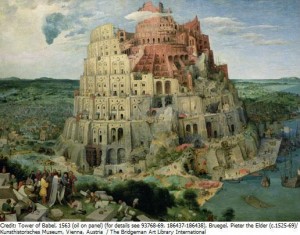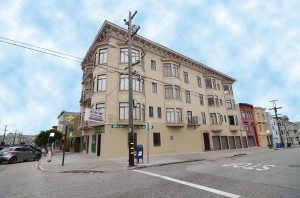Creating Free and Open Societies
From Free and Open Source Software, to
Non-profit High-tech Organizations, to
Debt-free Affordable Housing
Brewster Kahle, the club, May 12, 2014, cc-by v3 msword pdf
tl;dr summary: Public Licenses Rule (in software and creative works); but if extended further, Public Licenses could be better law structure to create Free and Open Societies within restrictive law systems.
Most of us participate in a few of different societies at the same time, say, our family and our country. If thought of this way, a society has its own rules and patterns, its own form of participation and success, its own myths as to how it is supposed to work. The American society is a political and economic one that is sold as democratic and based on equal opportunity.
Unfortunately, growing evidence is showing that American society is barely democratic and economic advancement is denied to most that work hard. A recent paper from Princeton evaluated of over 1700 federal government policy decisions made in the last 30 years and found “economic elites and organized groups representing business interests have substantial independent impacts on U.S. government policy, while average citizens and mass-based interest groups have little or no independent influence.” Therefore, according to this research, the vast majority of the population has little or no say in how the federal government makes policy decisions. Similarly discouraging is the economic analysis over the last 30 years that found that the increase in American wealth went to only the wealthiest 1% of the population, with the other 99% essentially staying even. Therefore, there has not been equal opportunity for economic success in the United States for the vast majority of the population.
To try to correct this divergence between the ideals of our society and reality, some are working on political solutions. But, interestingly, others are building alternative societies within the broader society. Societies that operate with different rules that seem more fair, more participatory, more generally beneficial. These societies do not have the power of law to help regulate them, so they have been creative in how to make them function.
This paper will explore some of these approaches to build societies with more participation and more opportunities for individual success. These societies are still embedded in a broader legal regime, one that does not share those values, but nevertheless can be used to protect the new societies’ rules if done cleverly. Specifically, the laws that create “property interests” in land and ideas can be used to defend subsets of people that want to share anyway. In this way, there have been attempts to create a balance for the public interest by creating sub-societies that operate with different rules and for different ends. While difficult to set up, we will see some have been successful, and if the government policy continues to dictated by small minorities, it may be worth building more systems based on this model.
An early example, again from the United States, came after the government declared most of the lands of the newly expanded United States to be private property in the 19th century, this did not sit very well with many. In a reaction to what was seen as “over-properitization” of land, the United States government started a National Park System in 1917 to somewhat counter this enclosure. Many individuals went on to donate or sell lands to the government to be protected for the common good as parks. But a new system of land control for the common good evolved, I imagine, as a reaction to the actions of government not serving that goal as well as desired: it is the growth of the Nature Conservancy founded in 1951, which is a non-profit that buys and accepts donations of land in order to protect it. It is interesting that it now protects 119 million acres of land, which is substantial considering the US National Parks system contains 85 million acres.
The donors were voluntarily limiting their ownership privileges, or just giving them up, in order to build a public commons that served the public interest. Thus a non-governmental approach was created, in this case leveraging a centralized organization, to benefit the broad public.
When another problem arose, this time with copyright, a distributed solution was created to fantastic effect: Free and Open Source Software. This voluntary releasing of property interests has gone on to be the foundation of many successful industries. This paper will discuss how this came about and how it might be used to go further to create other systems that benefit many more people than the system created by our government and corporations. While this approach is difficult to implement it seems to be a novel technique to counter the expansion of property interests.
Free Software Ideas
Richard Stallman created the idea of Free Software in 1984 as a reaction to a problem of 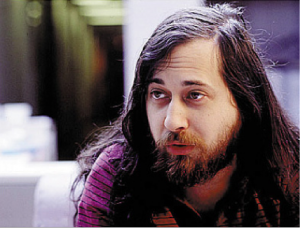 ‘propertization’ brought about by a major change in copyright law. When this propertization was applied to software it caused major problems, which lead Stallman to create a new and powerful tool– the Free Software License, or GNU General Public License. Using licenses in a new way, he sought to create an environment that encouraged sharing, as a kind of voluntary law structure when laws had caused unwanted division. This creative use of licenses, he called them “public licenses,” was a major innovation that built a decentralized law structure that people could voluntarily join.
‘propertization’ brought about by a major change in copyright law. When this propertization was applied to software it caused major problems, which lead Stallman to create a new and powerful tool– the Free Software License, or GNU General Public License. Using licenses in a new way, he sought to create an environment that encouraged sharing, as a kind of voluntary law structure when laws had caused unwanted division. This creative use of licenses, he called them “public licenses,” was a major innovation that built a decentralized law structure that people could voluntarily join.
Thus a society, within but different from the larger governing and corporate society, was deemed better by enough people that it went on to make difference in the important industries of high technology. In some important way, people opted out of the laws passed by the government to make a new, more free and open society, by using public licenses to govern themselves. Taking lawmaking into their own hands in this way was only necessary because the laws passed by the government were not serving many people very well.
Public License
Usually licenses are between two people or entities, but a “public license” is between an owner and the general public. So it is quite an unusual license, and one that may not have had a precedent before Richard Stallman. Also, a public license sticks. In other words, once the public license is legally affixed to a copyrighted work, or potentially other owned things, then then it does not expire and the public can continue to use the licensed work. A feature of works under the GNU General Public License is that they can be used in combination with other works under that License. In this way, a piece of software under the GPL can be linked and mixed with other GPL code, where it can not be mixed with proprietary code. This caused Microsoft to worry that this license could be a threat to its ongoing business, and as we have seen as GNU/Linux has expanded, they had reason to worry.
A Public License is different from a protocol, such as the World Wide Web protocols or the Internet Protocols in that a License carries responsibilities. Richard Stallman, and his lawyer Eben Moglen, thought about this carefully to try to avoid the works being used to undermine the freedoms he set out to ensure. The Internet protocols do not have any such responsibilities engendered in their use, so there was nothing to guarantee ongoing “net neutrality” from corporations or from government. Therefore the Public License has a defense structure built in.
Public Licenses are also different from non-profit ownership, such as the Nature Conservancy, in that it is decentralized and does not have a provision for after-the-fact changes. Some have objected to the Nature Conservancy selling some lands, for instance, in order to protect others. The distributed nature of the public license does not have change provisions, which has its own issues, but the control stays with the original owner.
Public licenses can evolve, and indeed the GNU General Public License is now on version 3, but any owner of a copyrighted work is free to use an older version of the license. The debates and process around the version changes are illustrative of how mature the whole process has become, but it is beyond the scope of this paper.
Creation of Free Software
How the GNU General Public License and Free Software came about might lets us see how we might apply this idea more broadly. (While I did not participate in the founding of the Free Software movement, I worked with many of the founders at that time and engaged with the technologies involved.)
In 1976, the US copyright law changed from opt-in to opt-out. This means that before 1976 to get copyright protection for a work– you had to put a little C in a circle on something you have written and send a copy to the Library of Congress. After 1976, you got copyright protection whether you wanted it or not for anything expressed in a fixed form. This is an astonishing change. Suddenly everything written had an owner, became property, and could not be copied without permission until the authors were 50 years dead. The first major problem with this new system came with software.
Starting in 1973, a group of staff members and graduate students at MIT wrote a new operating system called the Lisp Machine operating system. As a user of this, I can stay it was like nothing before and very powerful.
We were excited about building something significant and new. The source code in this project was not signed by anyone because that would be seen as arrogant– someone may have started a file with computer code in it as an initial version, but everyone was free to work on the software and make it better. It was a project in common, it was a commons.
But MIT, I imagine emboldened by the new copyright law, seemed to say to itself, if everything is owned by someone, then MIT owns this operating system, and therefore it can sell it to companies. Which it did, licensing it to Symbolics Corporation in 1979. This “forked” the code, by making a copy that would be worked on independently. Even though there was still a copy that could be developed at MIT and another company called Lisp Machines Incorporated, it meant that the developments at Symbolics were proprietary and separate. Users had to choose between versions with became incompatible.
Richard Stallman tried to keep the MIT version at feature parity, but it proved too hard, even for a prodigious programmer like Richard Stallman. The open version lost. To Stallman’s credit, he could see the future, and it was dark.
Symbolics grew and later died, and with it the Lisp Machine operating system. The system that could have been a major step forward effectively became the sole property of a single company and with that company it died. The shame is not that a company died– they all do, it is that it brought down a community effort that was more important than a company or some licensing fees for MIT.
Richard decided to stop working on the Lisp Machine operating system and build a new system that would not have this problem. This new system would be built on a legal framework that would not allow the software to be forked into a proprietary version. The innovation was to create the GNU General Public License and build software using it. The idea of using this license to rebuild an old and simple operating system, Unix, was just convenience, and in fact a technical sacrifice, in order to be able to get software going again without the property problem that brought down the Lisp Machine operating system.
Again, I was not actively in the early GNU project, but was at MIT at the time and helped in small ways. What I learned from this was how a creative use of licenses could be used to solve a societal problem brought about because of bad laws.
The problem with the law was the “over-propertization” which caused division and loss. Over-propertization made it difficult to work together, made it difficult to share, it created conflict when none was needed.
Richard Stallman’s solution was ingenious: use copyright law to try to recreate some of what we had before the law was massively expanded. He created a legal territory, a commons, in which people could write code that could be shared with one another, and would continue to be shared with one another. Larry Lessig called it “Share and share alike”. It works by saying in effect: I will share this work with everyone, and therefore anyone is free to use it for whatever they please. If anyone adds to my work, then they have to share the result of your work in the same way. Almost childlike in its simplicity, it seemed to express what people intended, and in fact what people were used to doing. It took massive effort by Richard Stallman to get this going, not just by writing fantastic code but by spending years on the road explaining and recruiting people to use this system.
Interestingly, he did this by creating a distributed system, with no centralized points of control. Unlike the Nature Conservancy, there was no one entity that controlled all the software. Rather it was an “opt-in” system of people used this “General Public License” a license for re-use requiring no coordination between parties.
And Free Software took off. By the mid 1990’s a usable Unix operating system, GNU / Linux, was used in production. The new Free Software license and then joined by related but different Open Source Licenses were used as the glue that allowed thousands of programmers and companies to cooperate to build the complex operating system. Without these Public Licenses, all code would be proprietary, and would require one-to-one licenses that would not scale to the requirements of cooperation need.
Key ideas in Free software were that there were no rents and no hoarding– everyone was free to use the software and build on it. If one did build on free software, then the results are shared in the same way. In this way, the commons would grow and stay protected from restrictions forever.
In general, Free and Open Source Software was a better system for many applications maybe because there can be many participants and many beneficiaries rather than just a few proprietary owners.
Stallman’s licensing system is the best ‘hack’ I have seen (‘hack’ in the sense used in the technical community): it allows people to evolve a working system, where working is determined by the system working better than alternatives and attracting adherents. If there is proof of work in one system then it gains value and momentum. By people participated more in one system rather than other systems, then the better system will come to be the most useful. It is a form of voting with participation and work. Other systems, evolving at the same time, would succeed or not by working better. It is a form of competition that lives underneath and within the rule of law. So these systems are all perfectly legal, so it is an evolution from within. It is an evolution that became necessary because the rule of law did not benefit enough people; so many opted for different rules that would produce a more productive and attractive environment.
The first hurdle the Free Software idea had to accomplish was to convince people they wanted to give up some rights in their work, or as Larry Lessig put it: “Some Rights Reserved.” This was not easy, but it gained momentum. Then, interestingly, there came to be other licensing arrangements, often collectively called “Open Source Licenses.” These became so numerous that a non-profit organization was formed, the Open Source Initiative, to adjudicate them. So there started to be competition even within this realm. The “GNU Public License” is now on version 3, after having succeeding version 2 after months of open debate. Thus an ecosystem of rule systems was born.
The law could have followed the same path and reflected the improvements tested by these system, and in which case, would have made these Herculean efforts unnecessary, but they haven’t. And as the study cited at the beginning of this paper has shown, the laws are responding to forces of the elite and and special interests rather than popular will.
While the Free Software movement could be an antidote to current problems in governance, the level of effort to make this type of system operate should not be underestimated, it would help society evolve much more rapidly and universally if there were feedback from these experiments back into the legislature, but there is little evidence of this yet.
The reason Richard Stallman’s “GNU General Public License” was needed in the first place was because the change in copyright law put everything written put under the burden and restrictions of copyright. A simple way to decrease the power of this new idea would be revoke some of the massive expansion of “property rights” created in 1976. Since Congress and the Supreme Court does not seem to be going in this direction at this point, we will see more approaches like Free Software, and indeed we have.
Creative Commons License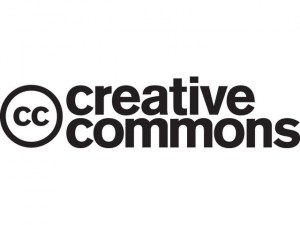
The next step in the evolution of public licenses was the Creative Commons License by Larry Lessig, who said he expanded on the ideas of GNU project. These public licenses applied the approach to movies, music, and written works. Some projects, like Wikipedia, had previously used the GNU license for textual works, but it did not fit very well, so when the Creative Commons Licenses were created, they adopted the version that is closest to the GNU one: called Creative Commons Share and Share Alike.
Before the Creative Commons Licenses were available, the Internet Archive struggled with the legal fees and agreements with those that wanted to add materials to the Internet Archive for free distribution. When these licenses were released, this became easier because the copyright holder could select which one they wanted, and there was no legal negotiation. A public license has proven understandable to the copyright holder and to the users of the materials from the web site. This has lead to over 1.5 million works being uploaded to the Internet Archive using these licenses.
Another major use of Creative Commons has been in academic publishing. As commercial entities acquired and raised fees to view academic papers, a reaction entity, the Public Library of Science was funded by Foundations to build an alternative. The papers published through this system, now over 80,000 a year, are all Creative Commons licensed and may be freely read. The new Digital Public Library of America is another example where it requires all contributions of library catalog records be Creative Commons licensed so that the holdings can be analyzed at once rather than having to track licensing agreements on a per-record basis.
While successful in reflecting many people’s interests, governments have not changed their laws. This means that the vast majority of works live under the default case– fully copyrighted. To help increase the responsiveness of government to public interests, the founder of Creative Commons Larry Lessig has gone on to try to concentrate on eliminating the corrupting influences of campaign contributions in politics to strike at the root cause of the problem.
Defensive Patent License
Patent laws create a monopoly on use of ideas for a period of time, which has lead to  severe problems and expenses for companies, problems such as patent trolls, vague patents, and expensive prosecutions[1].
severe problems and expenses for companies, problems such as patent trolls, vague patents, and expensive prosecutions[1].
I proposed applying the GNU Public License idea to patents in 2009 which has been pursued by several law professors and is being launched this year as the Defensive Patent License.
This system has the same interlocking nature of the GNU License in that anyone that registers their patents as defensive can then use all other defensive patents royalty free. All other uses are in the existing, litigation-filled environment.
While too early to tell if this will be widely adopted, it is being taken seriously by small and large corporations because of the flaws in the current patent system.
High Tech non-profit organizations
I have spent so long on public licenses because of what I see happened next, which is to apply these ideas to organizations, specifically, the evolving High-Tech non-profit sector. Organizations such as Wikimedia Foundation, Mozilla Foundation, the Internet Archive, and the Electronic Frontier Foundation, I contend, are interesting as a parallel, or maybe even a next step in the evolution of the Free Software ideas of Richard Stallman. If we think, for a moment, of them in this way, we might see even further steps we can go in this direction.
High-tech non-profit organizations are also a reaction to a problem: Over-propertization in corporations. Corporations, with their seeming obsessions with copyrights, patents, contracts, mergers and acquisitions, and non-disclosure agreements, are not a good fit for long-term commitments need to foster the sharing environment of free software and its developers.
So a solution was created: non-profit organizations that adopted free or open source principles as core values and sometimes as legal requirements.
Free Software Administrative Organizations
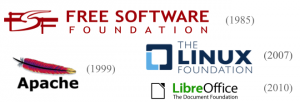
Some of the first of these were mostly administrative, such as the Free Software Foundation, again of Richard Stallman, established in 1985. The Linux Foundation (2007), the Apache Foundation (1999), Open Source Initiative (1998), and the Document Foundation (2010). These organizations help administer the licenses that are then used by a widely distributed set of programmers that might be in many different companies, universities, as well as individuals acting on their own behalf. By being non-profit organizations, they could not be bought, and they were not “property” as corporations are. They have no shareholders, rather they have a mission and a board to support that mission. By being mission-driven and regulated under US law, they are incorporated to serve the public.
Interestingly, sometimes Free and Open Source projects that start out in companies find a non-profit a better structure. For instance an open-source competitor to Microsoft Word, OpenOffice, started in a company as proprietary software, and was acquired by Sun Microsystems in 1999 which then open-sourced it (2000) and it became very popular. When Sun Microcomputer was purchased by Oracle Corporation (2010), a group forked the code (2010) into a non-profit named the Document Foundation in case it would not continue developing it and renamed it Libreoffice and publicly asked Oracle to open up. Oracle did so in 2011 by moving the project to the Apache Foundation. So the project has come to live in 2 different non-profits being a bit confusing for the time being. As a side note, it is interesting that Free Software does sometimes get forked which creates competitors. This is a dramatic action that is not taken lightly but has happened and provides a legal and legitimate way to make sure work continues in the public interest. Competition is supported even in the commons.
Support and Advocacy Non-Profits
Another stage in the evolution was the formation of non-profit organizations to support 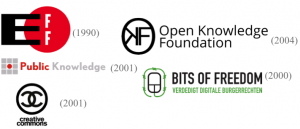 Free Software and related initiatives. Since many of these projects did not have an institutional structure, with employees and a legal department, the Electronic Frontier Foundation, founded in 1990, has been a pro-bono law firm for those trying to assert freedoms in the digital world. EFF has grown to be a major law firm and advocacy organization that owns its own building and is building an endowment, yet it gives away its core product– law advice and prosecutions. So in a way, the EFF is an “free software”-like organization in that it gives away its product, yet it has grown to be successful and important.
Free Software and related initiatives. Since many of these projects did not have an institutional structure, with employees and a legal department, the Electronic Frontier Foundation, founded in 1990, has been a pro-bono law firm for those trying to assert freedoms in the digital world. EFF has grown to be a major law firm and advocacy organization that owns its own building and is building an endowment, yet it gives away its core product– law advice and prosecutions. So in a way, the EFF is an “free software”-like organization in that it gives away its product, yet it has grown to be successful and important.
Interesting to me is how long these have lasted as compared to the generally short life of most high tech corporations. As an anecdote, at the 20th birthday party for the EFF in 2010, I asked a fellow board member, Mitch Kapor (who started Lotus Development Corporation (1982), famous for early spreadsheets), “have you ever been involved in something that has lasted 20 years?”, and he wittily replied “my marriage, I hope” and then recounted that the important and successful Lotus Development Corporation lasted only a few years before it was bought and became unrecognizable.
Other support organizations have been created such as Public Knowledge (2001) as a Washington DC public interest group to represent these interests to Congress and regulatory organizations.
Creative Commons (2001) started as a public license creating non-profit, but evolved into an advocacy organization as well, running projects and outreach. While similar to the Free Software Foundation, it successfully raised money to run projects with different communities to create new licenses and software all over the world. Bits of Freedom (2000), in Europe, has helped protect and expand these ideas, as well and the Open Knowledge Foundation (2004) in the UK.
Hybrid open-source and for-profit structures were tried such as WAIS, Incorporated (1992) was based around an open source system distributed in 1991. AOL later acquired this company in 1995, but the open source software continued somewhat. Cygnus Solutions (1989) offered commercial support for Free Software and was sold to Red Hat ten years later; Red Hat, itself, has been a corporation that has supported free software to varying degrees by creating a distribution of Linux. For that matter Ubuntu is also a hybrid that produces a free distribution of Linux but also sells services and support. WordPress by Automattic, another for-profit, maintains a popular open source software version of its core software that helped it outcompete an more proprietary system called Live Journal.
One important distinction between for-profit and non-profit organizations is that non-profits are very difficult to acquire, which may be because there is much less monetary incentive for leaders of a non-profit to merge with other organizations. This has lead to a continuation of the mission, which is the primary purpose of non-profits under US law.
High-Tech Non-Profits Go Operational
Some new high-tech non-profits are full-fledged infrastructure organizations, such as 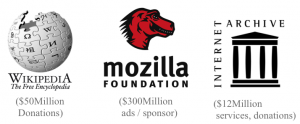 Wikipedia and the Internet Archive. While there have long been member-based or subscription-based services such as the ISP’s during the NSFnet era or shared infrastructure groups like JSTOR, those groups offered services only to their subscribers and do not adopt Public Licenses. The new high-tech non-profits are more like open source software in that they give away their main product to anyone.
Wikipedia and the Internet Archive. While there have long been member-based or subscription-based services such as the ISP’s during the NSFnet era or shared infrastructure groups like JSTOR, those groups offered services only to their subscribers and do not adopt Public Licenses. The new high-tech non-profits are more like open source software in that they give away their main product to anyone.
Where the open source administration and advocacy organizations did not need large staffs these operational organizations are growing staffs and facilities.
Mozilla Foundation, for instance, gets some money for itself through grants and donations, but its fully owned sub-company Mozilla Corporation currently earns about $300 million a year from Google basically for ads. With this income it employs over 1000 people in what appears to operate like a for-profit company, with for-profit salaries and structure, but it gives away its product.
The Public Library of Science is an interesting example because it competes with for-profit scientific journal publishers like Elsevier. This publisher operates on a writer-pays model, where those submitting a paper will pay $1000-$2000 and the resulting work is open and publicly available even in bulk. They have convincing statistics for the advantages to authors of publishing in open access journals in terms of citations and reuse over publishing with for-profit companies that limit who can read the articles. Having started with generous grants from the Moore Foundation and the Herb and Marion Sandler, they now more than cover their expenses and enjoy a $45 million budget.
Wikipedia raises about $50 million a year, and climbing, through user donations and grants. Its model has proven successful in keeping the free encyclopedia growing and heavily accessed, making it the 6th most popular website of all websites.
The Internet Archive gets most of its $12 million dollars a year from libraries to digitize books and collect web-pages that anyone can then access for free. But it has been evolving some new systems I will touch on in a moment.
So these high-tech non-profits organizations, as well as others such as Public.Resource.Org and the Internet Software Consortium, have made business models based on giving away their core product, and thrive while doing so. The models are evolving, but they have generally done well both through recession and boom times. These organizations are creating systems that have many beneficiaries, with low barriers to participation, and support decentralized structures. I find this encouraging towards thinking we might have a way to make free and open societies without having to wait for government or corporations to change their priorities.
The next question is to see if this approach can be used more widely, outside of the high-tech sphere, to be used to solve other problems our property focused countries have created.
Free and Open Ecosystem?
As I have been trying to make the Internet Archive financially sustainable, we are pursuing both raising more money and spending less. Spending less has invited some creative solutions that leverage the idea of public licenses.
We first focused on reducing external, non-salary costs. The Internet Archive has already bought its own buildings so that it does not have to pay rent, which has been a substantial cost savings, especially on datacenter costs. Also, the Internet Archive lowered its electricity use by about 50% by not using air conditioning and using external air to cool our machines. This unconventional approach has proven successful and is now being adopted by others. The Internet Archive went on to try to heat our own buildings using our computer heat to provide additional savings. Leveraging low cost machines, low cost hard drives, and then using these machines for multiple tasks have kept down the millions of dollars we spend each year on technology.
But we seem to be running out of ways to reduce our external costs. The Internet Archive now spends about 70% of its budget on staff costs. While the largest expense for some of our employees is private school fees for their children, the biggest cost for most of our employees is housing at between 30-60% of their take-home pay. Indeed some of our staff that scans books spend 60% of their income on rent for their family. It turns out that this range is not just a San Francisco phenomena, but a nationwide average. Diving another level deeper to find out why rents are so high, and it turns out it is debt service. About two thirds of rent people pay go to paying the mortgage on the apartment building, or the mortgage on their home as few of our employees own their homes outright.
So approximately 25% of the money we raise at the Internet Archive goes to service debt on our employee’s housing. Another way to look at it is that if we had debt-free housing we would not have to raise this money and might even have a higher standard of living.
Free and Open Housing?
To try to come up with a “Free and Open” approach to housing, we are trying something 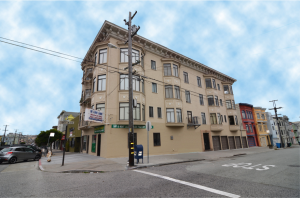 we are calling Foundation Housing. We set up a separate non-profit that bought an apartment building using donated funds to create affordable housing for non-profit workers. In some way it is taking an endowment out of the banking system and endowing housing for our employees. In this way, a permanent benefit can be afforded to the staff of the Internet Archive by leveraging an upfront donation. This system turns out to even work if there were not the up-front donation, but rather just a down payment that would allow an apartment building to be purchased with a mortgage. Since market-based rents generally cover mortgage, if we would not put subsequent debt on the building, the mortgage would be paid off in 30 years. As market-based rents tend to increase and fixed payments do not, most buildings are effectively paid off in 12 to 15 years. Therefore, if one does not have as much money up front, but is patient, there can be housing that is transitioned to be debt-free, and therefore can be used to supply affordable housing to these non-profit employees.
we are calling Foundation Housing. We set up a separate non-profit that bought an apartment building using donated funds to create affordable housing for non-profit workers. In some way it is taking an endowment out of the banking system and endowing housing for our employees. In this way, a permanent benefit can be afforded to the staff of the Internet Archive by leveraging an upfront donation. This system turns out to even work if there were not the up-front donation, but rather just a down payment that would allow an apartment building to be purchased with a mortgage. Since market-based rents generally cover mortgage, if we would not put subsequent debt on the building, the mortgage would be paid off in 30 years. As market-based rents tend to increase and fixed payments do not, most buildings are effectively paid off in 12 to 15 years. Therefore, if one does not have as much money up front, but is patient, there can be housing that is transitioned to be debt-free, and therefore can be used to supply affordable housing to these non-profit employees.
Key to this approach is to keep new debt from being put on the buildings. This is where the Public Licenses idea comes in. The GNU Public Licenses, for instance, binds a software program to be forever free. If we could create a Foundation Public License, then it would similarly be forever bound to not take on new debt. Properly constructed this would take away the incentive to sell or encumber properties with debt and therefore transition apartment buildings to enduringly debt-free housing.
Another feature of the Public License is who the building is to serve and how. The Foundation House will offer the employees of selected non-profits to take up residence and only charge the base cost of the building. Base costs are made up of upkeep, taxes, and insurance. The cost of debt would not be borne on those employees therefore making the fee for living there only one third of market rent. Also, those base costs do not fluctuate as rapidly as the market does, so the housing can a stable base for operating the non-profit.
If this model were to do as well as Free and Open Source Software did, then maybe it could expand to be 5% of all the housing units in a county. If we had easy-to-adopt Public Licenses and had the incentives aligned, then people may voluntarily contribute the properties or funding to pay the down payments in this transition.
The interlocking nature of Public Licenses could also benefit Foundation Housing by facilitating a pool of houses that could be interchanged between non-profits. In this way, employees might have the choice of many different Foundation Houses, even if they were started to serve different non-profits. In this way, this could encourage mixing of employees from different non-profits thus building a wider community.
Free and Open Housing could be made by using this model of Foundation Housing that would not take rent, over the base costs (more like a condominium fee) and have no owners that can profit from the selling the property out from underneath the tenants.[2]
Hopefully would we build a secure and enduring housing base that would be permanently affordable to those that work in the non-profit sector.
In case this idea works, we thought we would need to get financing for these buildings. As I found when I was starting a cooperative house in the Boston area in the 1980’s, the banks were not inclined to lend to such organizations.
Free and Open Banking?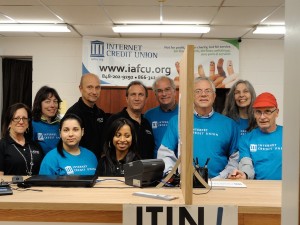
Building a lending institution that would support our “free and open” environment seemed like a natural step. The Internet Archive founded the non-profit and member run Internet Credit Union in 2012 for this purpose.
Credit Unions are tightly regulated, and in fact, they are mostly being shut down by the federal regulator, at about 300 a year, while only one or two are allowed to start in a year. Experiencing the tight strictures put on credit unions explains this death-to-birth ratio.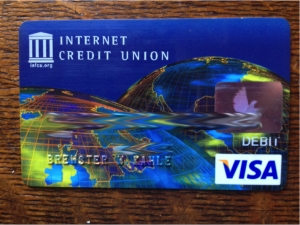
It may take years before our new credit union is allowed to lend money to help the housing situation, but the experiment has started. How it might expand to fulfill a Free software-like role is still to be explored. For now the credit union is trying to navigate the regulatory environment.
Conclusion
All in all, there seem to be ways to leverage Public Licenses to build non-governmental and non-corporate systems in order to create free and open structures that produce our goods and services. Pioneered in reaction to the “over-properterization” of software in the early 1980’s, it has come to be a way to dealing with similar trends for books, music, video, journal articles. Applying it further to patents, and even organizational structures as an alternative to the joint stock company structures is being tested. If we can extended it to housing, food, and even education, we might be able to create more free and open societies that serve many of the basic needs in an way that reflects the interest of a majority of people.
This creative approach to building organizations and societies that operates with different laws implemented with public licenses offers hope that we can live more productive and sharing lives.
[1] In one lawsuit that I testified in, Apple v Samsung, there were 45 full time lawyers just on the Samsung side on just the US version of the lawsuit.
[2] Rules being explored for Foundation Houses:
Owned by a special purpose non-profit (independent of the non-profits it serves),
Have 2 choices: market based rent & debt-free cost-based rent (like a condo fee),
Benefit particular non-profits, if extra money, then benefit making more Foundation Houses.

